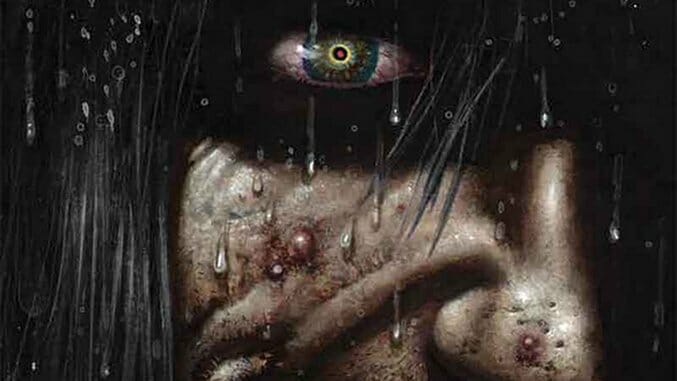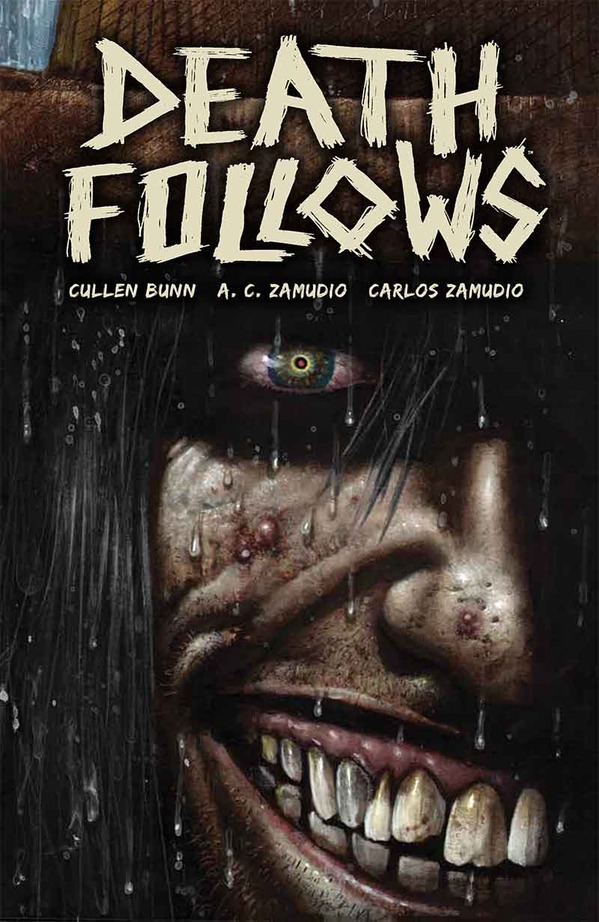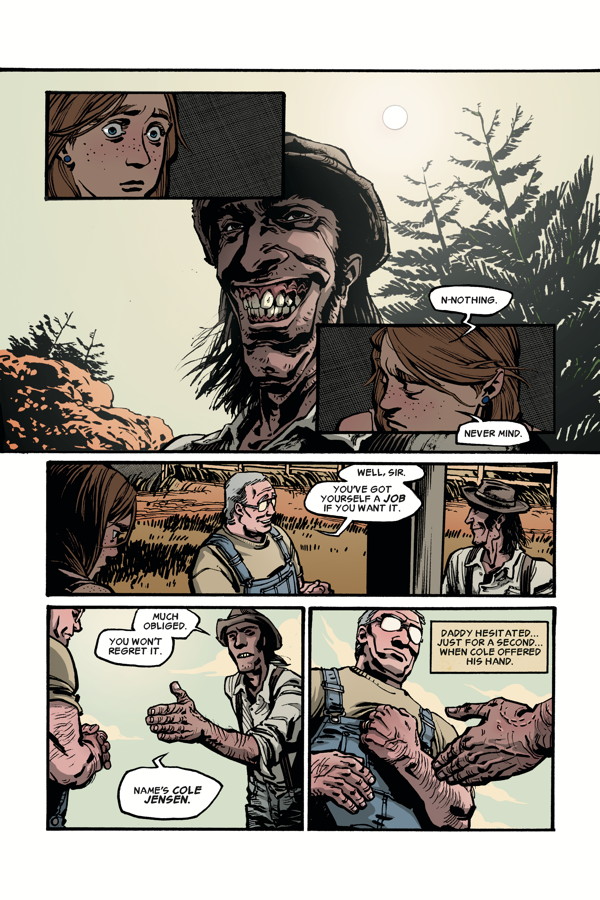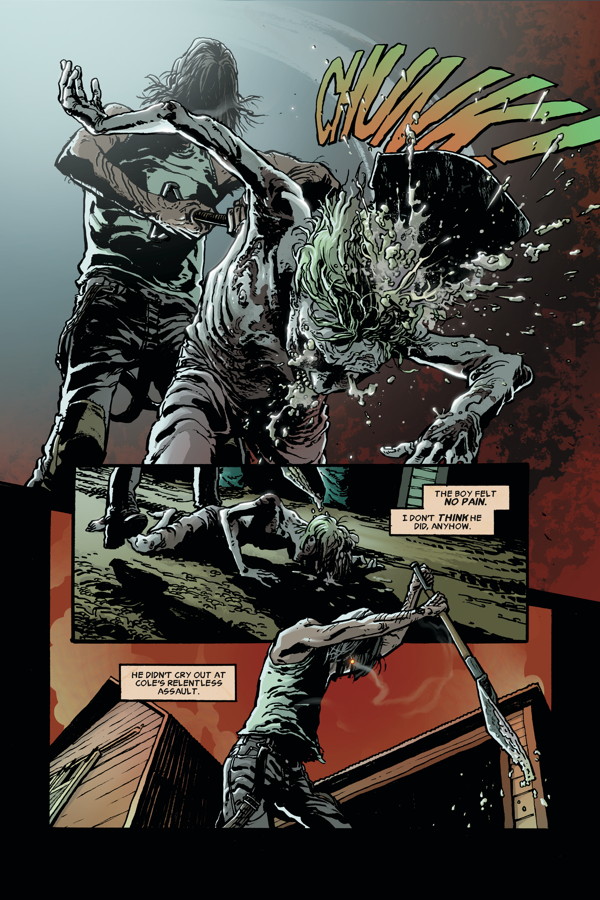
In recent years, Cullen Bunn’s deft command of high-concept horror has graced a host of memorable series. In The Sixth Gun, cowboys, demonic creatures and secret societies clash over a group of weapons that can reshape reality. Hellbreak offers an espionage procedural involving secret missions in the nasty side of the afterlife. And in his new graphic novel illustrated by A.C. Zamudio and colored by Carlos Zamudio, Death Follows, a woman named Birdie reflects on a disturbing window of her childhood, when a sinister man worked her family’s farm causing unsettling events (and reanimated corpses) to emerge. Death Follows has no shortage of uncanny and unsettling imagery, rooted in the agrarian folk horror he’s near-perfected in his current ongoing Harrow County with artist Tyler Crook. But Bunn and Zamudio prioritize the relationships between the members of Birdie’s family more than any stomach-churning frights. Paste emailed with Bunn about the evolution of Death Follows from a prose short story to the graphic novel, released this week from Dark Horse Comics, to his thoughts on what makes for compelling horror.![]()
Paste: Death Follows contains the original prose story that inspired this graphic novel. How frequently do you tend to work from a prose original? Does your process differ at all from when you’re writing something unique to the comics form?
Cullen Bunn: Adapting a prose story is something that I’ve only done a few times. I did it with Harrow County, which started as a prose novel, even though only a few chapters were written. I also adapted Blood Feud from novella to comic-book form. Death Follows makes the third such adaptation. I don’t know if it’s something you’ll see from me too often in the future, but it’s possible.
The process is vastly different between prose and comic work. I tend to do very little outlining when it comes to prose. I might have a vague idea of where I’m headed, but for the most part I’m just winging it. With comics, I do a great deal of outlining—several stages of it, in fact.

Death Follows Cover Art by Simon Bisley
Paste: The narrator of the prose version of the story is male; the narrator of the comic is female. What led to the change?
Bunn: That change was the result of a conversation with [Death Follows artist] A.C. Zamudio. She felt strongly that a female protagonist would bring something really interesting to the story. And she was absolutely right. The creation of Birdie really brought this story to life for me.
Paste: The story told in Death Follows has a very particular point of view, and several mysteries are left unexplained: particularly, how Cole Jensen came to have his particular relationship to the dead. How much more than the characters witnessing these events do you generally know?
Bunn: It depends on the story. In some cases, I know a great deal about the past of the characters, whether or not it ever gets mentioned in the story. In other stories—this one included—the backstory is a little more fluid. It’s more important to know Cole has this weird supernatural curse than it is to know how he got it. I have some thoughts about his origins, but I’d rather leave some of that for the reader to think about. We leave some visual clues behind, though, so keep an eye out.

Death Follows Interior Art by A.C. Zamudio and Carlos Zamudio
Paste: There are certain other details that are striking: the narrator’s father seems somewhat older than his wife, for instance. How important are details like that, that accentuate this fictional world?
Bunn: I felt like the age difference between the father and mother established an interesting dynamic in the story, one that I saw quite a bit when I was growing up in rural North Carolina. I just thought it made the story seem a little more real. Picture-perfect families are dull.
Paste: Your body of work includes plenty of supernatural stories, told as both prose and comics. What have you found over the years that makes for effective horror in each medium?
Bunn: Horror—in comics and prose—depends so much on establishing a sense of dread. The mood of the piece is a big part of what will stick with the reader and help to unsettle them. I also think it’s important to make your characters really come to life. I want the reader to care and worry about these characters.

Death Follows Interior Art by A.C. Zamudio and Carlos Zamudio
Paste: Does horror also make up a lot of what you read and watch when you’re not writing? What do you find scares you the most?
Bunn: I do watch and read a lot of horror, but I also read a lot of fantasy, crime and non-fiction books. I try to keep my horizons pretty broad.
As for what scares me most, I think a lot of it shows up in Death Follows. The idea of something happening to my kid haunts me.
Paste: Death Follows is a very self-contained work, whereas a book like The Sixth Gun is much more sprawling, with a fictional universe that can accommodate a host of subplots and spin-offs focusing on supporting characters. How soon into a project are you before you know which type of fictional universe you’re working in?
Bunn: I tend to know if a story will be finite, or not very, early on in a project. Sometimes, I plan an initial arc but hope for more. In the case of Death Follows, I always saw it as a short yarn. I thought that made the horrific aspects a little more cutting.

Death Follows Interior Art by A.C. Zamudio and Carlos Zamudio
Paste: Some of your horror stories involve well-known creatures like vampires and werewolves; others create their own specific cosmology. Are there any classic horror stories or tropes you’d like to revisit that you haven’t so far?
Bunn: That’s a tough question. Is “all of them” an all-right answer? I’ve written many classic horror creepy crawlies. I’d love to return to some of them again and present some new takes and the classics all over again.